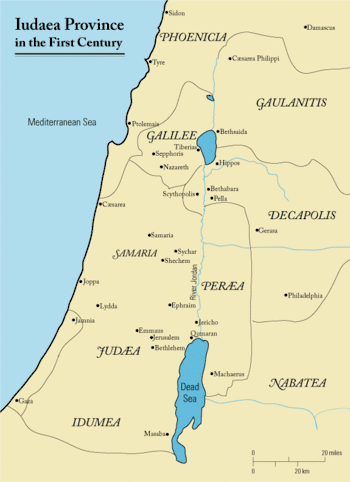Gabbatha
_-_James_Tissot.jpg)
Gabbatha (Aramaic גבתא) is the Aramaic name of a place in Jerusalem that is also referred to by the Greek name of Lithostrōtos (Greek λιθόστρωτος). It occurs only once in the Bible, in John 19:13.[1][2]
The Gospel of John states that Pontius Pilate:
- "brought Jesus forth, and sat down in the judgment seat, in the place that is called Lithostrotos, and in Hebrew Gabbatha."
The name "Gabbatha" is certainly an Aramaic word, which language was spoken commonly at the time in Judea. It is not a mere translation of "Lithostrotos," which properly means the tessellated or mosaic pavement where the judgment-seat stood, but which was extended to the place itself in front of Pilate's praetorium, where that pavement was laid. This was proved by the practice of St. John, who elsewhere gives Aramaic names as distinctly belonging to places, not as mere translations of the Greek. This is proved also because "Gabbatha" is derived from a root (meaning "back", or "elevation") which refers not to the kind of pavement, but to the "elevation" of the place in question. It thus appears that the two names "Lithostrotos" and "Gabbatha" were due to different characteristics of the spot where Pilate condemned Jesus to death. The Aramaic name was derived from the configuration of that spot, with the Greek name derived from the nature of its pavement.
Efforts have been made by commentators to identify "Gabbatha" either with the outer court of the Temple, which is known to have been paved, or with the meeting-place of the Great Sanhedrin, which was half within, half without that Temple's outer court, or again with the ridge at the back of the House of the Lord; but these efforts cannot be considered as successful. The only inference that can be gathered with certainty from St. John's statement in John 19:13 is that "Gabbatha" denotes the usual place in Jerusalem, where Pilate had his judicial seat, and whither he caused Jesus to be brought forth, that he might deliver, and in that of the Jewish multitude, his formal and final sentence of death by crucifixion.
References
This article incorporates text from the public domain Catholic Encyclopedia.
